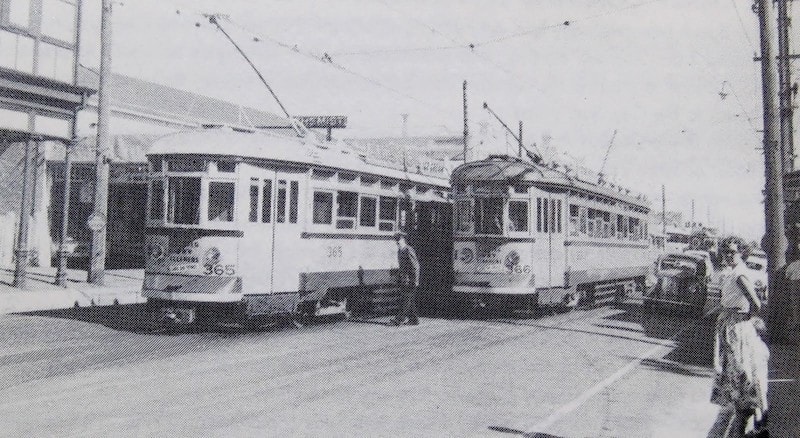Trams and Trains

Trams and trains featured prominently in the history of both Henley Beach and Grange!
It was trams that brought the first passengers to Henley beach though on a double-deck horse drawn tram travelling from Adelaide in the 1880s. In 1883 the horse tram line was extended from Henley to Grange, and this became the longest line in Adelaide. The line was a single track with passing loops. The tram couldn’t have the usual roof canopy to protect the top-deck passengers however because of the risk of seaside winds overturning the tram.
The horse tram also brought the mail to and from Adelaide. The tram service was so popular, especially during sailing regattas, that a 300-metre-long siding was built from Main Street to North Street to hold parked trams on days of special events.
Electric trams were introduced in 1909. The tramline from the city followed Henley Beach Road, over a viaduct (roughly where HMAS Australia Drive is now) then onto Seaview Road. Trams terminated at Main Street. The viaduct (a wooden trestle structure about half a mile long carried the trams above the normal level of the normal winter floods, but the service was often interrupted.
Trams stopped running in 1957.
Steam train services were introduced in February 1894 as an extension of the existing Grange line. The extension went south along Military Road to a terminus right here at the site of the current police station on Military Road. The Henley Beach railway station and terminus stretched from Main Street to Kent Street. The steam train with its six or so carriages would pull in and after the engine was uncoupled, it would proceed to the end of the line, where two water tanks were provided to fill up for the return journey to Adelaide. The engine would then go on a spur line, or loop, pass the standing carriages to where there was a turntable which was a favourite spot for children watching the steam trains being turned around, then go back on the spur line to be re-coupled up at the front, ready to move off when the time came. Station facilities consisted of an island platform and shelter with a ticket office.
The railway line from Grange to Henley was closed in August 1957 due to the track being close to public roads with no fencing between. Since then, Grange has again been the terminus of the service.
Image credit: Henley & Grange Historical Society
One of my aunts was quite a character. She was born in 1906 I believe, in Perth (W.A.), but within a couple of years the family had relocated to Grange. Living in many houses in Grange due to my Grandfather (her father), being a prominent builder at the time. And from 1948 until the 1990s, she lived in Jetty Street, Grange.
One of the funniest stories (to me) she ever told, was about her catching a tram back to Henley from town, when she was in her 20s.
Women’s undergarments were nothing like those today. And, because I lived with my Grandmother I knew about them as often helped her – how to lace her ‘stays’ (corset), and was mortified when hanging her ‘bloomers’ on our clothes line, as it was visible from the street (Military Road, Grange). Bloomers – Panties, Knickers, whatever they are called today. Elastic waist, like panties, but instead of elastic at the leg openings these had ‘legs’ to them, reaching down to the knees, sometimes with elastic the bottom also.
Anyway my aunt had caught the train to very busy Henley Square, and as she got off the tram, the elastic in the waist of her bloomers gave way, and they fell below her dress skirt, right down to the ground. I know I would have been mortified if that had happened to me. So I asked her what did she do, what did people say?
She said she quickly looked around, and no one appeared to notice, so she stepped out of them, stuck her nose up in the air, and continued walking as if nothing had happened.
I can imagine in the 1920s this would have been scandalous, especially in such a busy area. But laughed so hard at the thought of my aunt doing such a thing, and seemingly getting away with not being noticed. I think she was even proud that she had not be caught out.
Though, being told this as a child, I couldn’t help but wonder who might have found them in Henley Square, or on the tram’s steps, and what they might have done with them.
I do still remember tram service, I know I rode on it, but my memories are vague on it. I do remember that there was quite a lot of noise that came from them as they ran upon the rails.
Contrary to belief the horse tram did not terminate in Jetty St outside the hotel. It terminated in Beach St near what was to become the Scarfe house.
H&GHS Note: Although there is compelling anecdotal evidence in Wilson, T., Radcliffe, J. & Steele, C. ”(2022) “Adelaide Public Transport – the first 180 years”, Wakefield Press p.9 and Manning, G. (unpublished) “A Social History of Thebarton, Appendix 9 p. 3 to support a Beach St terminus on the Esplanade as suggested by the author there is no direct physical evidence to either confirm or refute this. (13/05/24).